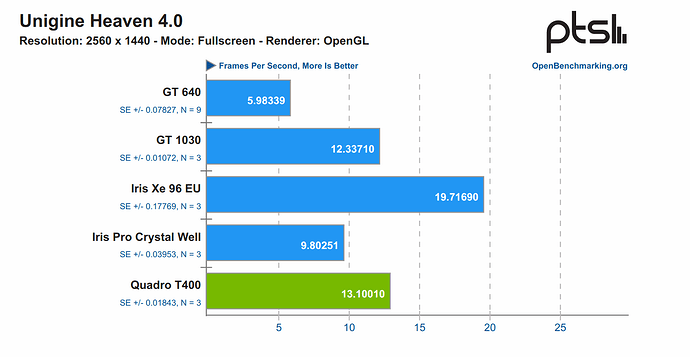I benchmarked the Intel Core i7-1165G7 in Linux against a whole slew of other CPUs I’ve had access to over many years.
I’m using:
- gnome-disk-utility
- Geekbench (DROPPED - see thread below)
- glmark2
- HardInfo
- nbench
and others where it’s harder to interpret or compare the results.
All tests were done plugged in with 100% battery.
Here’s the 1TB WD_BLACK SN850 in the Framework:
versus the same type of drive in my desktop:
(Sorry no write measurement, it can only be done offline.)
So - close but not quite. I’m thinking this may be due to the SN850 in a lower power state in the Framework? Or thermal throttling?
I won’t be getting into Geekbench, it seems I have something wrong. See the thread below.
Not too many results from 3D graphics benchmark glmark2.
But it does slightly exceed the performance of the old yet discrete NVIDIA GeForce GT 640 DDR3. It greatly exceeds the older high end Intel “Crystal Well” iGPU in the Core i7-4870HQ. It cannot match the performance of the low-end GDDR5 GPU, the NVIDIA GeForce GT 1030, or the low-end GDDR6 NVIDIA Quadro T400 though.
Lots of data from HardInfo!
This is a multithreaded benchmark and it’s a bit better than the Core i7-4870HQ but not quite up to the level of the Core i7-4790K. It does exceed quite a few desktop CPUs with much higher TDPs.
Here it completely outclasses all my older laptop CPUs, including the powerful Core i7-4870HQ by a small margin. It cannot quite equal the performance of the desktop Core i7-4790K.
This is a single threaded benchmark. It’s the 2nd fastest CPU I’ve ever tested and is just barely beaten by the monster Ryzen 9 5900X (105W TDP). Not bad for a 28W TDP CPU!
I’m unable to explain the strange, seemingly random results here.
This is only available in more recent versions of HardInfo so fewer CPUs were benchmarked. It beats two lower-powered Intel mobile CPUs but not the high performance Core i7-4870HQ. It also cannot match the relatively low-powered desktop Ryzen 3 3200G despite having HyperThreading, but it is at much lower TDP.
Testing fast Fourier transforms on the floating point unit, it seems that Intel’s recent performance here has fallen behind where they were. Older CPUs will beat it as well as all desktop AMD Ryzens. Performance is still decent but not leading.
The 1165G7’s FPU fares much better on raytracing, where it’s the fastest I’ve ever tested.
NBench is exclusively single-threaded, an area where the 1165G7 shines. Only the Ryzen 9 5900X beats it, and not by a huge margin. The Ryzen 7 3700X just barely beats it in integer calculations. There’s no evidence of any floating point weakness in this benchmark. This is especially impressive for a low TDP mobile CPU that has a lithography disadvantage over the AMD Ryzens (10 nm for the 1165G7 vs. 7 nm for the 3000 and 5000 Ryzens).
Conclusion
The Intel Core i7-1165G7 is a very fast CPU period, let alone the fact that it’s a 28W TDP mobile U-class CPU. It’s an extremely fast mobile CPU and even holds its own against much higher power desktop CPUs.
It is very impressive at single-core tasks. Multicore it cannot compete with 8C/16T or 12C/24T CPUs, but that should be obvious without benchmarking. However it beats other 4C/8T CPUs in most benchmarks so it is quite competitive.
This is no mean feat considering it’s a 10 nm thermally constrained mobile CPU competing against 7 nm desktop CPUs with much higher power limits.















